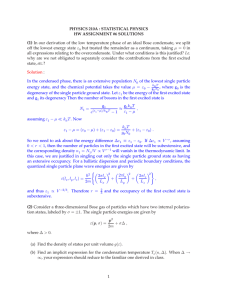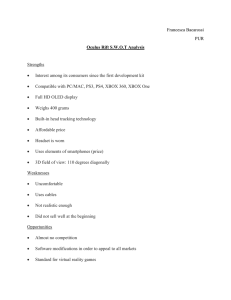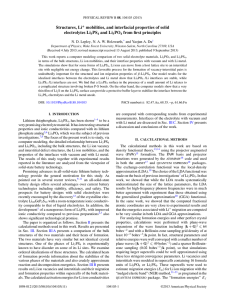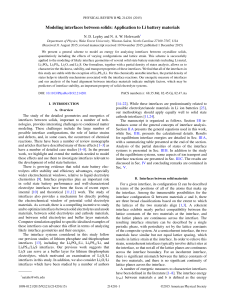Modeling the interface of Li metal and Li solid electrolytes... Abstract Nicholas Lepley, N. A. W. Holzwarth
advertisement
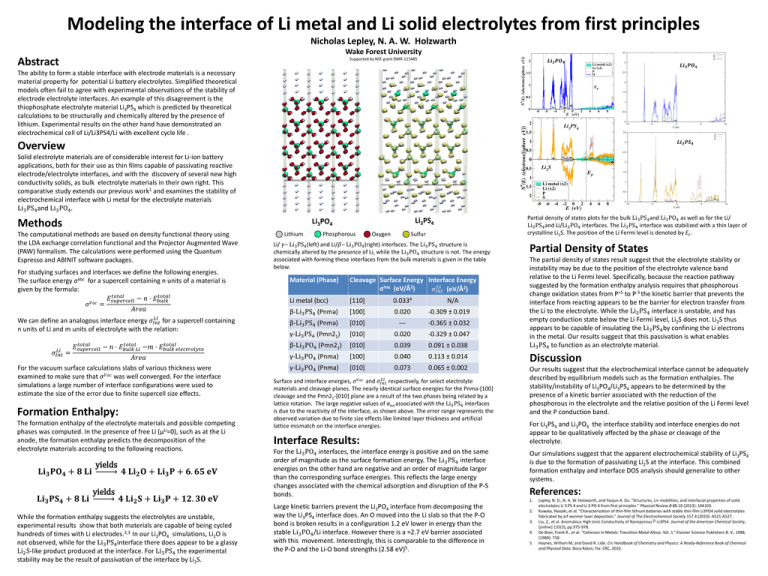
Modeling the interface of Li metal and Li solid electrolytes from first principles Nicholas Lepley, N. A. W. Holzwarth Wake Forest University Abstract Supported by NSF grant DMR-115485 𝑳𝒊𝟑 𝑷𝑶𝟒 𝑳𝒊𝟑 𝑷𝑶𝟒 The ability to form a stable interface with electrode materials is a necessary material property for potential Li battery electrolytes. Simplified theoretical models often fail to agree with experimental observations of the stability of electrode electrolyte interfaces. An example of this disagreement is the thiophosphate electrolyte material Li3PS4 which is predicted by theoretical calculations to be structurally and chemically altered by the presence of lithium. Experimental results on the other hand have demonstrated an electrochemical cell of Li/Li3PS4/Li with excellent cycle life . 𝑳𝒊𝟑 𝑷𝑺𝟒 Overview Solid electrolyte materials are of considerable interest for Li-ion battery applications, both for their use as thin films capable of passivating reactive electrode/electrolyte interfaces, and with the discovery of several new high conductivity solids, as bulk electrolyte materials in their own right. This comparative study extends our previous work1 and examines the stability of electrochemical interface with Li metal for the electrolyte materials Li3 PS4 and Li3 PO4 . Methods Li3PO4 The computational methods are based on density functional theory using the LDA exchange correlation functional and the Projector Augmented Wave (PAW) formalism. The calculations were performed using the Quantum Espresso and ABINIT software packages. For studying surfaces and interfaces we define the following energies. The surface energy σVac for a supercell containing n units of a material is given by the formula: 𝑡𝑜𝑡𝑎𝑙 𝑡𝑜𝑡𝑎𝑙 𝐸𝑠𝑢𝑝𝑒𝑟𝑐𝑒𝑙𝑙 − 𝑛 ⋅ 𝐸𝑏𝑢𝑙𝑘 𝜎𝑉𝑎𝑐 = 𝐴𝑟𝑒𝑎 𝐿𝑖 We can define an analogous interface energy 𝜎𝐼𝑛𝑡 for a supercell containing n units of Li and m units of electrolyte with the relation: 𝑡𝑜𝑡𝑎𝑙 𝑡𝑜𝑡𝑎𝑙 𝑡𝑜𝑡𝑎𝑙 𝐸 − 𝑛 ⋅ 𝐸 −𝑚 ⋅ 𝐸 𝑠𝑢𝑝𝑒𝑟𝑐𝑒𝑙𝑙 𝑏𝑢𝑙𝑘 𝑒𝑙𝑒𝑐𝑡𝑟𝑜𝑙𝑦𝑡𝑒 𝑏𝑢𝑙𝑘 𝐿𝑖 𝐿𝑖 𝜎𝐼𝑛𝑡 = 𝐴𝑟𝑒𝑎 For the vacuum surface calculations slabs of various thickness were examined to make sure that 𝜎𝑉𝑎𝑐 was well converged. For the interface simulations a large number of interface configurations were used to estimate the size of the error due to finite supercell size effects. Formation Enthalpy: The formation enthalpy of the electrolyte materials and possible competing phases was computed. In the presence of free Li (μLi=0), such as at the Li anode, the formation enthalpy predicts the decomposition of the electrolyte materials according to the following reactions. 𝐋𝐢𝟑 𝐏𝐎𝟒 + 𝟖 𝐋𝐢 𝐋𝐢𝟑 𝐏𝐒𝟒 + 𝟖 𝐋𝐢 yields yields 𝟒 𝐋𝐢𝟐 𝐎 + 𝐋𝐢𝟑 𝐏 + 𝟔. 𝟔𝟓 𝐞𝐕 𝟒 𝐋𝐢𝟐 𝐒 + 𝐋𝐢𝟑 𝐏 + 𝟏𝟐. 𝟑𝟎 𝐞𝐕 While the formation enthalpy suggests the electrolytes are unstable, experimental results show that both materials are capable of being cycled hundreds of times with Li electrodes.2,3 In our Li3PO4 simulations, Li2O is not observed, while for the Li3 PS4 interface there does appear to be a glassy Li2 S-like product produced at the interface. For Li3 PS4 the experimental stability may be the result of passivation of the interface by Li2S. Lithium Partial density of states plots for the bulk Li3 PS4 and Li3 PO4 as well as for the Li/ Li3 PS4 and Li/Li3 PO4 interfaces. The Li3 PS4 interface was stabilized with a thin layer of crystalline Li2S. The position of the Li Fermi level is denoted by EF . Li3PS4 Phosphorous Sulfur Oxygen Li/ 𝛾‒ Li3 PS4 (left) and Li/𝛽‒ Li3 PO4 (right) interfaces. The Li3 PS4 structure is chemically altered by the presence of Li, while the Li3 PO4 structure is not. The energy associated with forming these interfaces from the bulk materials is given in the table below. Material (Phase) Cleavage Surface Energy Interface Energy 𝐿𝑖 σVac (eV/Å2) 𝜎𝐼𝑛𝑡 (eV/Å2) Li metal (bcc) [110] 0.0334 β-Li3 PS4 (Pnma) [100] 0.020 -0.309 ± 0.019 β-Li3 PS4 (Pnma) [010] --- -0.365 ± 0.032 γ-Li3 PS4 (Pmn21) [010] 0.020 -0.329 ± 0.047 β-Li3 PO4 (Pmn21) [010] 0.039 0.091 ± 0.038 γ-Li3 PO4 (Pnma) [100] 0.040 0.113 ± 0.014 γ-Li3 PO4 (Pnma) [010] 0.073 0.065 ± 0.002 N/A 𝐿𝑖 Surface and interface energies, 𝜎𝑉𝑎𝑐 and 𝜎𝐼𝑛𝑡 respectively, for select electrolyte materials and cleavage planes. The nearly identical surface energies for the Pnma-[100] cleavage and the Pmn21-[010] plane are a result of the two phases being related by a lattice rotation. The large negative values of σInt associated with the Li3 PS4 interfaces is due to the reactivity of the interface, as shown above. The error range represents the observed variation due to finite size effects like limited layer thickness and artificial lattice mismatch on the interface energies. Interface Results: For the Li3 PO4 interfaces, the interface energy is positive and on the same order of magnitude as the surface formation energy. The Li3 PS4 interface energies on the other hand are negative and an order of magnitude larger than the corresponding surface energies. This reflects the large energy changes associated with the chemical adsorption and disruption of the P-S bonds. Partial Density of States The partial density of states result suggest that the electrolyte stability or instability may be due to the position of the electrolyte valence band relative to the Li Fermi level. Specifically, because the reaction pathway suggested by the formation enthalpy analysis requires that phosphorous change oxidation states from P+5 to P-3 the kinetic barrier that prevents the interface from reacting appears to be the barrier for electron transfer from the Li to the electrolyte. While the Li3 PS4 interface is unstable, and has empty conduction state below the Li Fermi level, Li2S does not. Li2S thus appears to be capable of insulating the Li3 PS4 by confining the Li electrons in the metal. Our results suggest that this passivation is what enables Li3 PS4 to function as an electrolyte material. Discussion Our results suggest that the electrochemical interface cannot be adequately described by equilibrium models such as the formation enthalpies. The stability/instability of Li3PO4/Li3PS4 appears to be determined by the presence of a kinetic barrier associated with the reduction of the phosphorous in the electrolyte and the relative position of the Li Fermi level and the P conduction band. For Li3PS4 and Li3PO4 the interface stability and interface energies do not appear to be qualitatively affected by the phase or cleavage of the electrolyte. Our simulations suggest that the apparent electrochemical stability of Li3PS4 is due to the formation of passivating Li2S at the interface. This combined formation enthalpy and interface DOS analysis should generalize to other systems. References: 1. Large kinetic barriers prevent the Li3PO4 interface from decomposing the way the Li3PS4 interface does. An O moved into the Li slab so that the P-O bond is broken results in a configuration 1.2 eV lower in energy than the stable Li3 PO4 /Li interface. However there is a ≈2.7 eV barrier associated with this movement. Interestingly, this is comparable to the difference in the P‐O and the Li-O bond strengths (2.58 eV)5. 2. 3. 4. 5. Lepley, N. D., N. A. W. Holzwarth, and Yaojun A. Du. "Structures, Li+ mobilities, and interfacial properties of solid electrolytes Li 3 PS 4 and Li 3 PO 4 from first principles." Physical Review B 88.10 (2013): 104103. Kuwata, Naoaki, et al. "Characterization of thin-film lithium batteries with stable thin-film Li3PO4 solid electrolytes fabricated by arf excimer laser deposition." Journal of The Electrochemical Society 157.4 (2010): A521-A527. Liu, Z., et al. Anomalous High Ionic Conductivity of Nanoporous β-Li3PS4. Journal of the American Chemical Society, [online] 135(3), pp.975-978. De Boer, Frank R., et al. "Cohesion in Metals: Transition Metal Alloys. Vol. 1.“ Elsevier Science Publishers B. V., 1988, (1988): 758. Haynes, William M, and David R. Lide. Crc Handbook of Chemistry and Physics: A Ready-Reference Book of Chemical and Physical Data. Boca Raton, Fla: CRC, 2010.
